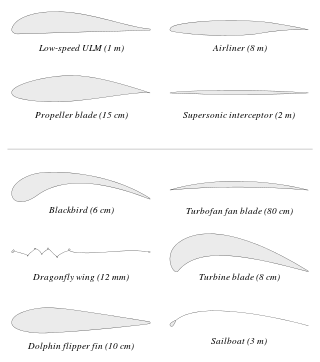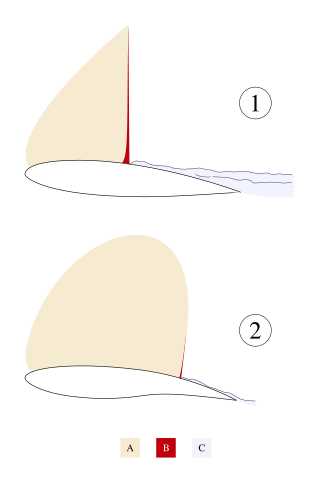The drag-divergence Mach number (not to be confused with critical Mach number) is the Mach number at which the aerodynamic drag on an airfoil or airframe begins to increase rapidly as the Mach number continues to increase. [1] This increase can cause the drag coefficient to rise to more than ten times its low-speed value.
The value of the drag-divergence Mach number is typically greater than 0.6; therefore it is a transonic effect. The drag-divergence Mach number is usually close to, and always greater than, the critical Mach number. Generally, the drag coefficient peaks at Mach 1.0 and begins to decrease again after the transition into the supersonic regime above approximately Mach 1.2.
The large increase in drag is caused by the formation of a shock wave on the upper surface of the airfoil, which can induce flow separation and adverse pressure gradients on the aft portion of the wing. This effect requires that aircraft intended to fly at supersonic speeds have a large amount of thrust. In early development of transonic and supersonic aircraft, a steep dive was often used to provide extra acceleration through the high-drag region around Mach 1.0. This steep increase in drag gave rise to the popular false notion of an unbreakable sound barrier, because it seemed that no aircraft technology in the foreseeable future would have enough propulsive force or control authority to overcome it. Indeed, one of the popular analytical methods for calculating drag at high speeds, the Prandtl–Glauert rule, predicts an infinite amount of drag at Mach 1.0.
Two of the important technological advancements that arose out of attempts to conquer the sound barrier were the Whitcomb area rule and the supercritical airfoil. A supercritical airfoil is shaped specifically to make the drag-divergence Mach number as high as possible, allowing aircraft to fly with relatively lower drag at high subsonic and low transonic speeds. These, along with other advancements including computational fluid dynamics, have been able to reduce the factor of increase in drag to two or three for modern aircraft designs. [2]
Drag-divergence Mach numbers Mdd for a given family of propeller airfoils can be approximated by Korn's relation: [3]

where
 is the drag-divergence Mach number,
is the drag-divergence Mach number, is the coefficient of lift of a specific section of the airfoil,
is the coefficient of lift of a specific section of the airfoil,- t is the airfoil thickness at a given section,
- c is the chord length at a given section,
 is a factor established through CFD analysis:
is a factor established through CFD analysis: - K = 0.87 for conventional airfoils (6 series), [4]
- K = 0.95 for supercritical airfoils.

Aerodynamics is the study of the motion of air, particularly when affected by a solid object, such as an airplane wing. It involves topics covered in the field of fluid dynamics and its subfield of gas dynamics, and is an important domain of study in aeronautics. The term aerodynamics is often used synonymously with gas dynamics, the difference being that "gas dynamics" applies to the study of the motion of all gases, and is not limited to air. The formal study of aerodynamics began in the modern sense in the eighteenth century, although observations of fundamental concepts such as aerodynamic drag were recorded much earlier. Most of the early efforts in aerodynamics were directed toward achieving heavier-than-air flight, which was first demonstrated by Otto Lilienthal in 1891. Since then, the use of aerodynamics through mathematical analysis, empirical approximations, wind tunnel experimentation, and computer simulations has formed a rational basis for the development of heavier-than-air flight and a number of other technologies. Recent work in aerodynamics has focused on issues related to compressible flow, turbulence, and boundary layers and has become increasingly computational in nature.

The Mach number, often only Mach, is a dimensionless quantity in fluid dynamics representing the ratio of flow velocity past a boundary to the local speed of sound. It is named after the Austrian physicist and philosopher Ernst Mach.

Supersonic speed is the speed of an object that exceeds the speed of sound (Mach 1). For objects traveling in dry air of a temperature of 20 °C (68 °F) at sea level, this speed is approximately 343.2 m/s. Speeds greater than five times the speed of sound (Mach 5) are often referred to as hypersonic. Flights during which only some parts of the air surrounding an object, such as the ends of rotor blades, reach supersonic speeds are called transonic. This occurs typically somewhere between Mach 0.8 and Mach 1.2.

Aeroelasticity is the branch of physics and engineering studying the interactions between the inertial, elastic, and aerodynamic forces occurring while an elastic body is exposed to a fluid flow. The study of aeroelasticity may be broadly classified into two fields: static aeroelasticity dealing with the static or steady state response of an elastic body to a fluid flow, and dynamic aeroelasticity dealing with the body's dynamic response.

In fluid dynamics, the drag coefficient is a dimensionless quantity that is used to quantify the drag or resistance of an object in a fluid environment, such as air or water. It is used in the drag equation in which a lower drag coefficient indicates the object will have less aerodynamic or hydrodynamic drag. The drag coefficient is always associated with a particular surface area.

The Prandtl–Glauert singularity is a theoretical construct in flow physics, often incorrectly used to explain vapor cones in transonic flows. It is the prediction by the Prandtl–Glauert transformation that infinite pressures would be experienced by an aircraft as it approaches the speed of sound. Because it is invalid to apply the transformation at these speeds, the predicted singularity does not emerge. The incorrect association is related to the early-20th-century misconception of the impenetrability of the sound barrier.

Transonic flow is air flowing around an object at a speed that generates regions of both subsonic and supersonic airflow around that object. The exact range of speeds depends on the object's critical Mach number, but transonic flow is seen at flight speeds close to the speed of sound, typically between Mach 0.8 and 1.2.
In aeronautics, wave drag is a component of the aerodynamic drag on aircraft wings and fuselage, propeller blade tips and projectiles moving at transonic and supersonic speeds, due to the presence of shock waves. Wave drag is independent of viscous effects, and tends to present itself as a sudden and dramatic increase in drag as the vehicle increases speed to the critical Mach number. It is the sudden and dramatic rise of wave drag that leads to the concept of a sound barrier.

In aeronautics, the aspect ratio of a wing is the ratio of its span to its mean chord. It is equal to the square of the wingspan divided by the wing area. Thus, a long, narrow wing has a high aspect ratio, whereas a short, wide wing has a low aspect ratio.

An airfoil or aerofoil is a streamlined body that is capable of generating significantly more lift than drag. Wings, sails and propeller blades are examples of airfoils. Foils of similar function designed with water as the working fluid are called hydrofoils.

In aerodynamics, the lift-to-drag ratio is the lift generated by an aerodynamic body such as an aerofoil or aircraft, divided by the aerodynamic drag caused by moving through air. It describes the aerodynamic efficiency under given flight conditions. The L/D ratio for any given body will vary according to these flight conditions.

Richard Travis Whitcomb was an American aeronautical engineer who was noted for his contributions to the science of aerodynamics.
In aerodynamics, lift-induced drag, induced drag, vortex drag, or sometimes drag due to lift, is an aerodynamic drag force that occurs whenever a moving object redirects the airflow coming at it. This drag force occurs in airplanes due to wings or a lifting body redirecting air to cause lift and also in cars with airfoil wings that redirect air to cause a downforce. It is symbolized as , and the lift-induced drag coefficient as .

Parasitic drag, also known as profile drag, is a type of aerodynamic drag that acts on any object when the object is moving through a fluid. Parasitic drag is a combination of form drag and skin friction drag. It affects all objects regardless of whether they are capable of generating lift.

In aerodynamics, the critical Mach number of an aircraft is the lowest Mach number at which the airflow over some point of the aircraft reaches the speed of sound, but does not exceed it. At the lower critical Mach number, airflow around the entire aircraft is subsonic. Supersonic aircraft such as the Concorde and combat aircraft also have an upper critical Mach number at which the airflow around the entire aircraft is supersonic.

A supercritical aerofoil is an airfoil designed primarily to delay the onset of wave drag in the transonic speed range.
In fluid dynamics, drag is a force acting opposite to the relative motion of any object moving with respect to a surrounding fluid. This can exist between two fluid layers or between a fluid and a solid surface.
In aeronautics and aeronautical engineering, camber is the asymmetry between the two acting surfaces of an airfoil, with the top surface of a wing commonly being more convex. An airfoil that is not cambered is called a symmetric airfoil. The benefits of cambering were discovered and first utilized by George Cayley in the early 19th century.
A supersonic airfoil is a cross-section geometry designed to generate lift efficiently at supersonic speeds. The need for such a design arises when an aircraft is required to operate consistently in the supersonic flight regime.
Aerodynamics is a branch of dynamics concerned with the study of the motion of air. It is a sub-field of fluid and gas dynamics, and the term "aerodynamics" is often used when referring to fluid dynamics















